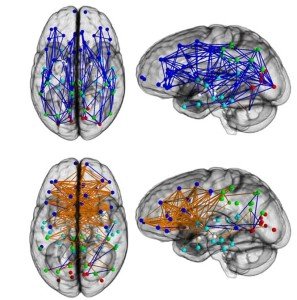
Do gender stereotypes reflect physical differences in men’s and women’s brains?
A study finding different patterns of connectivity in men’s and women’s brains appears in the journal Proceedings of the National Academy of Sciences (PNAS) this week. Researchers involved have claimed their results align with long-held stereotypes, showing women’s brains are “hard-wired” for improved multi-tasking, social skills and memory with men’s brains more oriented towards linking perception and coordinated actions.
Our colleagues at the UK SMC gathered the following expert comments on the study;
Prof Dorothy Bishop, Professor of Developmental Neuropsychology, University of Oxford, said:
“I think this study is potentially interesting but the suggested implications are in my opinion overhyped. For example, the description of effects as ‘hardwired’ is very misleading; brain connectivity can change with training and this is currently an active area of research, e.g. studies on brain plasticity.
“A previous large study examining similar things with 400 people did not find the same results as this study, which suggests that the current sample is either unusual, or that effects are very small at the individual level. The way the results are shown graphically makes them look dramatic, but the effects are likely to be very small – I suspect differences within each gender are considerably larger than differences between genders. In addition, we know very little about who the people were in the study. All we’re told is what race they were, and this was significantly different for the males and females, so it’s possible this also had an effect. I also think that it is going well beyond the data to draw conclusions about the functional significance of these effects when the authors don’t report any data on behaviour in this sample.”
Dr Adam Hampshire, Senior Lecturer in Restorative Neurosciences, Imperial College London, said:
“The suggestion that the left hemisphere of the human brain supports logical thinking whereas the right supports intuition is pop psychology and has little grounding in current models of brain functional organisation. Whilst there are certainly going to be some differences between male versus female brains in terms of structure and small differences in cognition are well established, there are some questions that any journalists looking at this need to ask. Most prominently, have the authors taken brain size into account? It doesn’t look to me like they have. The imaging methods they have used, DTI tractography, are very sensitive to the physical distance between nodes and males tend to have slightly larger brains, which would certainly drive illusory differences in connectivity. This issue is especially the case with such a large sample size which will provide the statistical power to detect small effect sizes. Statistical significance levels in analyses with large numbers of data points are not really informative, it is the size of the effect that matters. Also, to make claims regarding the relationship between connectivity and cognition, would require that correlations were examined between cognitive measures (e.g. working memory capacity) and connection strengths within group. It looks to me like no such analyses were conducted.”
Prof Heidi Johansen-Berg, Wellcome Trust Senior Research Fellow, Professor of Cognitive Neuroscience, FMRIB Centre, University of Oxford, said:
“We know that there is no such thing as ‘hard wiring’ when it comes to brain connections. Connections can change throughout life, in response to experience and learning. As far as I can tell, the authors have not directly related these differences in brain connections to differences in behaviour. It is a huge leap to extrapolate from anatomical differences to try to explain behavioural variation between the sexes. The brain regions that have been highlighted are involved in many different functions.
“‘Connectomics’ is a newly emerging field of neuroscience which offers great potential. The brain ‘connectome’ can be described at different levels – from the microscopic scale where the connections of individual brain cells are described, to the macroscopic level described here, where large scale connections between brain regions are described. Often, sophisticated mathematical approaches are used to analyse and describe these brain networks. These methods can be useful to identify differences between groups, but it is often challenging to interpret those differences in biological terms – for example the properties of transitivity and modularity mentioned here are difficult to interpret. It would be helpful to be able to relate these features of the brain wiring to measurements of brain function and behaviour.”